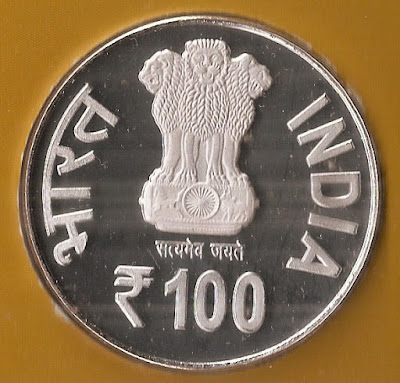1258) Centenary of Jallianwala Bagh Massacre (1919-2019): A Commiserative Quaternary Alloy Coin of Rs.100/- denomination, dated 2019, received on 02.03.2020 from the India Government Mint, Kolkata:
For my comprehensive post on the Jallianwala Bagh Massacre stamps issued in 2019, please visit the following link:
For my comprehensive post on the Jallianwala Bagh Massacre stamps issued in 2019, please visit the following link:
I have received a Rs.100/- Commiserative Quaternary Alloy Collector Coin (50% Silver, 40% Copper, 5% Nickel, 5% Zinc) from the India Government Mint, Kolkata on the Centenary of the Jallianwala Bagh Massacre (1919-2019).
The Cover of the Coin Album shows the Memorial at the Jallianwala Bagh Shrine. It is titled "Jallianwala Bagh Narsanhar Shatabdi" (in Hindi) and "CENTENARY OF JALLIANWALA BAGH MASSACRE" (in English).
On the lower section is mentioned - "Samvedna Sikka" (in Hindi) and "COMMISERATIVE COIN" (in English).
The Cover of the Coin Album shows the Memorial at the Jallianwala Bagh Shrine. It is titled "Jallianwala Bagh Narsanhar Shatabdi" (in Hindi) and "CENTENARY OF JALLIANWALA BAGH MASSACRE" (in English).
On the lower section is mentioned - "Samvedna Sikka" (in Hindi) and "COMMISERATIVE COIN" (in English).
At the right hand corner is mentioned - "PROOF SET". (Interestingly, although only a single coin has been issued, the Mint has been previously issuing a Rs.5/- or Rs.10/- coin together-with the Quaternary Silver commemorative coins and marking the coins as a "set". This seems to be an aberration on the part of the Kolkata Mint, seeing that only a single coin has been issued here).
The Back Cover of the Coin Album shows the India Government Mints symbol at left and mentions the India Government Mint, Alipore, Kolkata.
A composite image of Pages two and three of the Coin Album
Page two gives a brief description of the Jallianwala Bagh Massacre in Hindi.
Page three gives a brief description of the specifications of the Quaternary Silver Coin together with the Obverse of the Rs.100/- Coin.
The Obverse of the Rs.100/- Quaternary Silver Commiserative Coin shows the Emblem of the Government of India in the centre, derived from the Lion Capitol of the legendary Samrat Ashok (Emperor) of Ancient India. The words "Satyamev Jayate" (meaning "Truth will always Prevail") are inscribed below the Lion Capitol emblem.
On the left periphery is the country name "BHARAT" (in Hindi) and on the right periphery is the country name "INDIA" (in English).
The denomination of the Coin - "(Rupee symbol) 100" is mentioned at the lower periphery.
On the left periphery is the country name "BHARAT" (in Hindi) and on the right periphery is the country name "INDIA" (in English).
The denomination of the Coin - "(Rupee symbol) 100" is mentioned at the lower periphery.
A composite image of pages four and five of the Coin Album.
Page four of the Coin Album gives the specifications of this Commiserative Coin in English -
Denomination: Rs.100/-; Metal Composition: Quaternary Silver - Silver 50%, Copper 40%, Nickel 5% Zinc 5%.; Shape: Circular; Outside Diameter/Size: 44.0 mm; Weight: 35.0 grams; No. of Serrations: 200.
Denomination: Rs.100/-; Metal Composition: Quaternary Silver - Silver 50%, Copper 40%, Nickel 5% Zinc 5%.; Shape: Circular; Outside Diameter/Size: 44.0 mm; Weight: 35.0 grams; No. of Serrations: 200.
The Reverse of the Rs.100/- Quaternary Silver Commiserative Coin shows the Jallianwala Bagh Memorial in the centre. The inscriptions on the upper periphery are - "JALLIANWALA BAGH NARSANHAR SHATABDI" (in Hindi) and on the lower periphery - "CENTENARY OF JALLIANWALA BAGH MASSACRE" (in English).
Page five of the Coin Album gives a brief description of the Jallianwala Bagh Massacre:
"On the day of Baisakhi (harvest Festival) a large crowd had gathered on13th April 1919 at Amritsar in the Jallianwala Bagh to celebrate their harvest festival. Most of the people were unaware that the city was under curfew. Some leaders and their followers also gathered in the same Bagh (Garden) to protest against the arrest of their popular leaders - Dr. Saifuddin Kitchlew and Dr. Satyapal Malik.
General Dyer, the military commander of Amritsar, without any warning, gave an order to fire on the unarmed crowd, killing hundreds of them. The Bagh was surrounded by high walls and the only one gate was manned by Dyer's army.
The massacre exposed the true nature of colonial rule. It was condemned worldwide. Under pressure, the Government appointed an enquiry commission headed by William Hunter, ex-Solicitor-General and the Senator of the "College of Justice in Scotland". As expected, nothing serious came out from the enquiry. An English newspaper of England "The Morning Post", even collected funds to defend General Dyer".
"On the day of Baisakhi (harvest Festival) a large crowd had gathered on13th April 1919 at Amritsar in the Jallianwala Bagh to celebrate their harvest festival. Most of the people were unaware that the city was under curfew. Some leaders and their followers also gathered in the same Bagh (Garden) to protest against the arrest of their popular leaders - Dr. Saifuddin Kitchlew and Dr. Satyapal Malik.
General Dyer, the military commander of Amritsar, without any warning, gave an order to fire on the unarmed crowd, killing hundreds of them. The Bagh was surrounded by high walls and the only one gate was manned by Dyer's army.
The massacre exposed the true nature of colonial rule. It was condemned worldwide. Under pressure, the Government appointed an enquiry commission headed by William Hunter, ex-Solicitor-General and the Senator of the "College of Justice in Scotland". As expected, nothing serious came out from the enquiry. An English newspaper of England "The Morning Post", even collected funds to defend General Dyer".










No comments:
Post a Comment